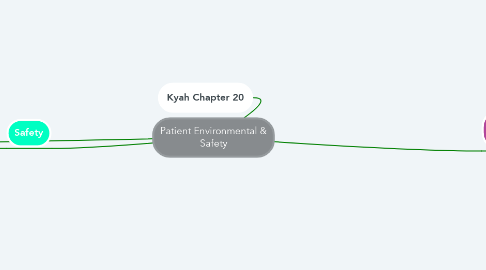
1. Falls
1.1. Impaired Physical Mobility
1.2. Altered Mental Status
1.3. Sensory/Motor Deficits
1.4. Assess: Medications, Age, Environmental Hazards
1.5. Utilize alarms properly
2. Safety
2.1. Falls, Burns, Cuts, Bruises are most common accidents w/ pts
2.2. Correctly identify patients
2.3. Improve communication
2.4. Infection control & prevention
2.5. Proper techniques to prevent pressure ulcers
3. Kyah Chapter 20
4. Factors Affecting the Environment
4.1. Temperature
4.1.1. Infants & Elderly need warmer rooms
4.1.1.1. Keep Temp between 68F-74F
4.1.2. Operating rooms and CCU areas kept cooler to reduce pt's metabolic demands.
4.2. Ventilation
4.2.1. Process to supply continuous fresh air.
4.2.1.1. Fans discouraged: wind currents spread microorganisms
4.2.1.2. Hospital windows do not open for safety
4.2.1.3. Air Conditioning units regulate temps, humidity, & air exchange
4.2.1.4. Negative Air Flow: Pts w/ certain respiratory issues & Burns (Airflow INTO the room)
4.2.1.5. Positive Air Flow: Some other pts (Airflow OUT of the room)
4.3. Noise Control
4.3.1. Proper home lighting protects against crime
4.3.2. Utilize curtains & signs when available to maintain pt dignity
4.3.3. Facilities may cause sensory overload.
4.3.3.1. Disturbs sleep pattern
4.3.3.2. Interfere w/ healing
4.3.3.3. Increase BP
4.3.3.4. People is #1 cause
4.3.3.5. Encourage staff to limit conversations and avoid overuse of intercoms
4.4. Humidity
4.4.1. Amount of moisture in the air
4.4.1.1. Normal between 30-50%
4.4.1.2. Low humidity dries skin and respiratory passages. Discourages microorganism growth
4.5. Lighting
4.5.1. Adequate light needed for procedures
4.5.1.1. Prevents accidents & injury
4.5.1.2. Bright - no eye strain; no glare
4.5.1.3. Soft - diffuse/prevent shadows
4.6. Odor Control
4.6.1. Sensory perception may change for various reasons
4.6.1.1. Control odor w/ proper ventilation and cleanliness
4.7. Interior Design
4.7.1. Sunny & cheerful may improve pt's mood
4.7.2. Provide a homelike environment, not a sterile feeling
4.8. Neatness
4.8.1. Neatness helps w/ safety
4.8.2. Home setting: look for hazzards and educate pt & family
4.8.3. Allow pt's personal belongings w/o allowing clutter, but ask permission prior to throwing away readables.
4.8.4. Straighten unit after making bed and with each visit to the room
4.8.5. Remove dishes and unused equipment promptly
4.9. Privacy
4.9.1. Knock gently
4.9.1.1. Identify yourself prior to entering
